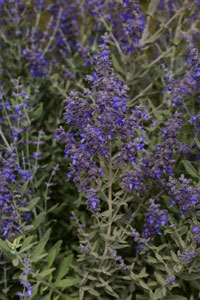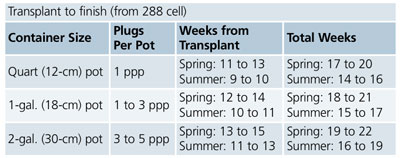3/31/2016
Perovskia Blue Steel: Stronger, Longer Perennial Color
Cor de Jong

The new Perovskia Blue Steel from PanAmerican Seed is a perennial first—now growers can produce high-quality, affordable
Perovskia atriplicifolia from professional-grade seed. With higher and much more uniform germination, top-notch plugs are easy and efficient to grow as a late-spring/summer crop or in fall for overwintering production. Blue Steel extends your sales: It combines the best summer-blooming lavender-blue color with outstanding late-season garden performance. As a cost-efficient seed, Blue Steel is affordable to use multiple plugs in each pot that finish with huge retail appeal.
Perovskia Blue Steel is a day-neutral plant. Vernalization is not required, but it does have a high light requirement (a light accumulator for flowering). Beyond that, it’s a breeze to grow! Here are some additional guidelines for getting the best from this newcomer.
Germination (2 to 4 days)
Use a well-drained, disease-free, soilless media with a pH of 5.8 to 6.2 and EC of 0.75 to 1.0 mmhos/cm. Sow 1 seed per cell in 288 or 180 plug trays, 2 to 3 seeds per cell in 128 or larger trays. Cover the seeds with vermiculite to improve moisture for uniform
germination.
Stage 1—Provide soil temperature between 65 to 72F (18 to 22C). Light is optional for germination. Keep soil wet (level 4) during Stage 1 and maintain 95% to 97% relative humidity (RH) until radicles emerge.
Plug production
Stage 2—In this stage set the soil temperature between 65 to 68F (18 to 20C) and provide light up to 2,500 f.c. (26,900 Lux). Maintain high moisture level (level 4) through stage 2. Apply fertilizer at rate 1 (less than 100 ppm N; less than 0.7 mmhos/cm EC) from nitrate-form fertilizers with low phosphorous. Maintain 80 to 85% relative humidity (RH).
Stage 3—Maintain soil temperature and light levels at stage 2. You can now allow the soil moisture to dry to level 3. Increase fertilizer to rate 2 (100 to 175 ppm N; 0.7 to 1.2 mmhos/cm EC). Blue Steel is a compact variety, so generally plant growth regulators are not needed. If necessary, daminozide (B-Nine, Alar) 1,500 ppm (1.8 g/l 85% formulation or 2.3 g/l of 64% formulation) will give good height control. For planning a pinch later, a lower rate of daminozide at 750 to 1,000 ppm (0.9 to 1.2 g/l 85% formulation or 1.0 to 1.5g/l of 64% formulation) with multiple applications (2 to 3 times) will tone the plugs well. Maintain 70% to 75% relative humidity (RH).
Stage 4—Drop soil temperature to 60 to 65F (15 to 18C) and increase light levels up to 5,000 f.c. (54,000 Lux). Moisture and fertilizer are the same as Stage 3. In Stage 4, a pinch is recommended. Pinch as early as possible to reduce possible crop time delay, but it’s necessary to leave 3 to 4 nodes below pinch for sufficient branches.
Growing on to finish
Use a well-drained, disease-free, soilless media with coarse parts with a pH of 5.8 to 6.2 and an EC of 1.0 to 1.2 mmhos/cm. Optimum night temperature: 55 to 60F (13 to 16C); optimum day temp: 65 to 72F (18 to 22C).
Note: Blue Steel can be grown in cooler temperatures; when grown under low light conditions, cooler temperatures will make more stiff stems. However, it will slow plant growth significantly. Perovskia foliage could be damaged by frost. Spring outdoor production should wait until critical frost period has passed.
High light is still required during finishing (≥12 mol•m-2•d-1, optimum ≥15 mol•m-2•d-1). Plants will flower faster and with stronger stems when grown under high light conditions. It is light accumulator for flowering.
Blue Steel requires average to slightly below average amounts of irrigation. Let media dry slightly between waterings and never get saturated. Plants also should not be allowed to wilt at any time. Provide moderate fertilization. Use a balanced fertilizer at rate 150 to 200 ppm N as needed or constant liquid fertilizer with 75 to 100 ppm N with each irrigation. Increase potassium to nitrate ratio in later growing-on stage. Maintain media pH 5.8 to 6.2 and EC 1.2 to 1.5 mmhos/cm.
Growth regulators
To regulate growth, use multiple applications (3 to 4 times) of daminozide: (B-Nine/Alar) 2,500 to 5,000 ppm (3.0 to 6.0 g/l 85% formulation or 3.9 to 7.8 g/l of 64% formulation) controls plant height and promotes branching. Optional PGR: Multiple applications of paclobutrazol (Bonzi, Piccolo) 20 to 30 ppm spray or multiple applications of uniconazole (Sumagic, Concise) 10 to 15 ppm spray.
Pinching is recommended if the plugs did not receive any pinching. Pinching can be done 2 to 3 weeks after transplant; leave 4 to 5 nodes below pinching level. Note: Pinch after transplanting can delay crop time.
GT
Crop scheduling

Cor de Jong is Global Product Manager—Perennials for PanAmerican Seed/Kieft Seed. He is based in The Netherlands. For more information, visit www.panamseed.com.